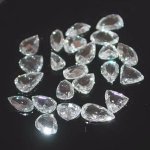We offer layaway, spread payments on the piece of your dreams. Ask us for details. Free insured shipping on all orders !!!

Antique jewelry glossary
Welcome to our extensive antique jewelry glossary with around 1,500 jewelry related entries.If you feel you are missing an explanation, feel free to let us know and we will add it.
A - B - C - D - E - F - G - H - I - J - K - L - M - N - O - P - Q - R - S - T - U - V - W - X - Y - Z all
Rose cut diamonds

See our: jewelry with rose cut diamonds.
Thank you for visiting our site, we think you came to the right place because we are specialized in antique jewelry in general and jewelry with rose cut diamonds in particular. Most of our jewelry with rose cut diamonds is of European origin. We strive to offer you only those pieces of antique jewelry with rose cut diamonds that will pass our quality tests. We have in-house antique jewelry experts specialized in various disciplines such as diamond experts, gemologists, antique jewelry restorers and antique jewelry appraisers.
We believe that this site shows some of the dedication our team has to quality control and service. Offering you good quality and wearable antique jewelry with rose cut diamonds at interesting prices is what we strive for.
Rose cut diamonds: The standard rose cut, also called the Dutch rose cut, has 24 triangular facets: 6 star facets meeting at a point at the top and 18 cross facets. Due to the absence of pavilion, many rose cuts are foiled back with a silver foil reflector.
In or around 1476 Lodewyk (Louis) van Berquem, a Flemish polisher of Bruges (Belgium), introduced absolute symmetry in the disposition of facets. He cut stones in the shape known as pendeloque or briolette; these were pear-shaped with triangular facets on both sides. About the middle of the 16th century, the rose or rosette was introduced in Antwerp: it also consisted of triangular facets arranged in a symmetrical radiating pattern, but with the bottom of the stone left flatessentially a crown without a pavilion. Many large, famous Indian diamonds of old (such as the Orloff and Sancy) also feature a rose-like cut; there is some suggestion that Western cutters were influenced by Indian stones, because some of these diamonds may predate the Western adoption of the rose cut. However, Indian "rose cuts" were far less symmetrical as their cutters had the primary interest of conserving carat weight, due to the divine status of diamond in India. In either event, the rose cut continued to evolve, with its depth, number and arrangements of facets being tweaked. (This paragraph has been copied from Wikipedia: Diamond cut)
The rose cut lost popularity in the early 18th century, when the brilliant cut was invented. But the beginning of the 20th century saw a slight revival of the cut. In those days, when there would be too much weight loss if a stone was to be polished into a brilliant, people might opt for one or two rose cuts. When the stone is cut so that it is in the form of two rose-cut stones placed base to base, it is called a double rose cut. Sometimes, the rose cut has been used for stones set in jewelry when the designer, such as Fabergé, wished the other ornamentation to dominate. Famous rose-cut diamonds include "the Great Mogul" and "the Orlov".
Usually, when speaking about a rose cut, people refer to a cone-shaped diamond (or an other prescribed symmetrical form) featuring a variable number of facets (usually two horizontal rows rising to a point) and a flat bottom (which means no pavilion).
It is important to bear in mind that the rose cut is first of all a cut. It is like the emerald cut. You can have emerald cuts as diamonds, as emerald or as diamond. And it also applies for rose cuts. You can have garnet rose cuts, as well as diamond rose cuts. This is important since knowing that helps avoiding a frequent misuse of the vocable rose cut.
Further more, the word "rose" itself could also be misleading as it comes from the flower, the "rose" and means "pink". Therefore, when you find an object that is described as featuring rose cuts, without further information, do not take it for granted and make sure that the stones are cut in diamond or check their color. A rose-cut diamond is also known as a Rose Diamond.
There are several varieties of rose cuts:
- The Brabant rose cut (or Antwerp rose cut)
- The Rose recoupιe cut
- The cross rose cut
- The six-facets rose
- The three-facets rose
- The mode rose
- The Chiffre
- Varieties of the brilliant having a flat base:
- The marquise rose cut
- The pendeloque rose cut
See our: jewelry with rose cut diamonds.









